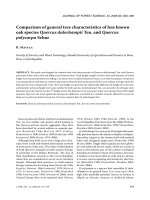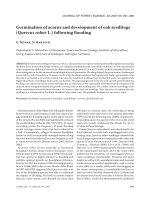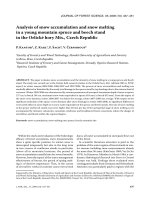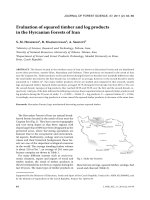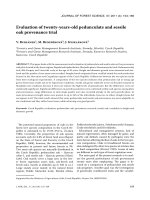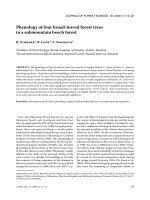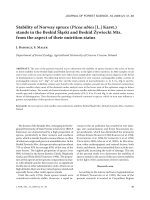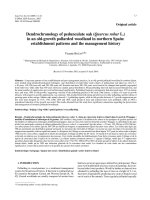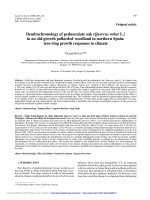Báo cáo lâm nghiệp: " Dendrochronology of pedunculate oak (Quercus robur L.) in an old-growth pollarded woodland in northern Spain: tree-ring growth responses to climate" pptx
Bạn đang xem bản rút gọn của tài liệu. Xem và tải ngay bản đầy đủ của tài liệu tại đây (443.01 KB, 10 trang )
209
Ann. For. Sci. 62 (2005) 209–218
© INRA, EDP Sciences, 2005
DOI: 10.1051/forest:2005012
Original article
Dendrochronology of pedunculate oak (Quercus robur L.)
in an old-growth pollarded woodland in northern Spain:
tree-ring growth responses to climate
Vicente ROZAS
a,b
*
a
Departamento de Biología de Organismos y Sistemas, Universidad de Oviedo, Catedrático Rodrigo Uría, 33071 Oviedo, Spain
b
Present address: Departamento de Ecología, Centro de Investigaciones Forestales y Ambientales de Lourizán, Carretera a Marín km 4,
Apartado 127, 36080 Pontevedra, Spain
(Received 13 November 2003; accepted 15 September 2004)
Abstract – Both time-independent and time-dependent responses of radial growth in pedunculate oak (Quercus robur L.) to climate were
investigated in an old-growth woodland in the Cantabrian lowlands, northern Spain. This was done by using correlation analysis, bootstrapped
response functions and Kalman filter analysis. Responses to climatic factors were explored in three different oak age-classes: young
< 120 years, mature 170–225 years old, and old-growth trees 250–470 years. Time-independent climatic models showed age-specific responses.
Between 55.2 to 66.8% of ring-width discovered variance was explained by weather conditions in the period 1940–1998. Radial growth of
young oaks was limited by the temperatures in June of the year the ring was formed, while mature and old-growth oaks showed a negative
response to winter and summer temperatures, and a positive one to summer precipitation. Time-dependent models revealed that the effect of
several climatic variables on tree growth was not constant through time. This variability could be explained by physiological changes related
to tree ageing, while it was unrelated to changes in other environmental factors. Overall, these results suggest that any assumption of an age-
independent climate-growth relationship for oak in the studied locality is unreliable, and anticipate the probable responses of oaks growing in
old-growth woodlands to global climatic changes.
climate / dendroecology / Kalman filter / response function / ring width
Résumé – Étude dendrologique du chêne pédonculé (Quercus robur L.) dans une forêt âgée, d’arbres traités en têtard, du nord de
l’Espagne : influence du climat sur la largeur des cernes. Dans une forêt âgée, située à basse altitude dans la région Cantabrique, on a étudié
les relations entre le climat et la largeur des cernes chez le chêne pédonculé (Quercus robur L.) ces relations pouvant être indépendantes ou
dépendantes du temps. Pour ce faire, on a fait appel à la méthode de rééchantillonnage (bootstrapped response functions) et au filtre de Kalman.
Les réponses aux facteurs climatiques ont été recherchées dans trois classes d’âge des chênes à savoir : les sujets jeunes (inf. à 120 ans), les
sujets matures (170 à 225 ans), les très vieux arbres (250 à 470 ans). Les modèles climatiques indépendants du temps révèlent des réponses liées
spécifiquement à l’âge. Entre 55,2 et 66,8 % de la variance de l’épaisseur des cernes s’expliquent par les conditions climatiques au cours de la
période 1940–1998. L’accroissement en diamètre des jeunes chênes est limité par les températures du mois de Juin de l’année de formation du
cerne, tandis que chez les arbres matures ou très vieux, on enregistre une réponse négative avec les températures hivernales ou estivales, et une
réponse positive avec l’augmentation des précipitations estivales. Les modèles dépendant du temps révèlent que l’effet des diverses variables
climatiques sur la largeur des cernes n’est pas constant dans le temps. Cette variabilité pourrait s’expliquer par des changements d’ordre
physiologiques liés au vieillissement des arbres ; elle ne peut être attribuée à des modifications d’autres facteurs de l’environnement. En
conclusion, ces résultats permettent de douter de l’existence d’une relation climat/accroissement des cernes indépendantes de l’âge pour le
chêne dans la zone étudiée. Ils contribuent aussi à entrevoir les conséquences probables de changements climatiques sur les vieux peuplements
de chêne.
climat / dendroécologie / filtre de Kalman / fonction de réponse / largeur des cernes
1. INTRODUCTION
One objective of dendroclimatology focuses on the use of
tree-ring widths to obtain information about long-term varia-
tion in climate. Tree-rings contain a wealth of information
about the climatic conditions that affect the growth of trees and
influence forest yield and sustainability [15]. In temperate
deciduous forests the radial growth of trees has been reported
to be less sensitive to climate than in arid woodlands and forests
found near their latitudinal or altitudinal limit of distribution
where there are more limiting conditions [15]. However, it has
been discovered that climate is an important factor influencing
* Corresponding author:
Article published by EDP Sciences and available at or />210 V. Rozas
the radial growth of tree species in temperate latitudes, in sites
not traditionally considered to be largely limited by climate [7,
14, 46, 54].
It is commonly accepted that the response of tree-ring
growth to climate is constant through time, covering the com-
plete life-span of trees [15]. However, the assumption that the
relationship between tree-ring widths and climate is time-stable
is questionable, considering the nature of tree ring data and the
possibility that climate, and other environmental factors, can
change over time [31, 56, 59]. It has also been stated that the
history of a tree significantly affects its growth, and tree-ring
response to climate can be dependent on age [8, 52]. Neverthe-
less, the introduction of the Kalman filter into dendroclimato-
logical analyses has resulted in the development of continu-
ously variable time-dependent relationships between climate
and growth [57–59]. Several studies have demonstrated that
growth-climate relationships can change over time according
to variations in stress factors, such as acidic-deposition or inter-
tree competition [4, 28, 44].
In Europe, pedunculate oak (Quercus robur L.) has proved
to be an important species for dendrochronological studies.
Archaeological oak timber has been used to successfully date
historical buildings [23, 32], and long chronologies, appropri-
ate for use in radiocarbon calibration, have been built from sub-
fossil oak wood preserved in peat bogs and river gravels [1, 39,
40]. Tree-ring responses of pedunculate oak to climate fluctu-
ations have been widely studied in Europe [2, 21, 25, 38, 55].
In northern Spain, studies on oak dendrochronology [17, 18,
34], on the climatic response of pedunculate oak [19, 44], and
climatic reconstructions from oak ring-width chronologies [35]
have been performed.
In this work, the relationship between tree growth and cli-
mate variables was investigated in Tragamón, an old-growth
oak woodland in the Cantabrian lowlands, northern Spain.
Time-independent and time-dependent responses of ring-width
variation to monthly precipitation and temperature were esti-
mated by using correlation analysis, bootstrapped response
functions and Kalman filter analysis. Age-specific responses to
climatic factors were explored in different oak age-classes. The
objectives, relative to the radial-growth patterns of pedunculate
oak and their responses to climatic variability, were: (1) to cal-
culate the similarities in radial growth patterns among different
tree age-classes, (2) to differentiate the climatic variables that
determine tree-ring growth in each age-class, (3) to estimate the
temporal shifts in the climatic response of oak, and (4) to assess
the individual responses of single trees to climate, according
to their agreement with common growth patterns.
2. MATERIALS AND METHODS
2.1. Climatic data
A complete record of temperature and precipitation, from 1939 to
1998, was obtained from the Gijón meteorological station (Asturias,
Spain), 29 m asl, and approximately 2 km north-west of the study site.
The climate in the area is Atlantic, with temperate and wet winters,
and periods of summer drought in occasional years. Rainfall records
at the weather station of Gijón showed a minimum from June to
August, and a maximum from October to January, with a mean annual
precipitation of 977 mm (Fig. 1). Maximum temperature values occur
in July and August, while minimum temperatures are observed from
December to February, with a mean annual temperature of 13.9 ºC
(Fig. 1). Total annual rainfall and mean annual temperatures, from
1940 to 1998, are shown in Figure 1.
2.2. Field and laboratory procedures
All old-growth and mature living oaks, without external evidence
of bole decay, and a random sample of young oaks, were cored with
increment borers in autumn 2000. Since Tragamón is a protected area,
only one core per tree was taken, 100 cm above ground level, in order
to minimise the damage to the trees. Two cores were taken in a few
mature trees. Cores were air-dried, glued to wooden mounts and surfaced
Figure 1. Climatic diagram of Gijón, Spain (43º 33’ N, 05º 39’ W) for 1939–1998. The range of variation of mean temperature (shaded area)
is shown. T: mean annual temperature, P: mean annual precipitation. The variation of total annual precipitation and mean annual temperature,
with their general trends, are shown.
Article published by EDP Sciences and available at or />Dendrochronology of oak: responses to climate 211
with progressively finer grades of sandpaper. Tree-ring series were
dated following standard procedure [50]. Ring-widths were measured
under magnification to the nearest 0.01 mm with a Velmex UniSlide
sliding-stage micrometer interfaced with a computer. The COFECHA
computer program [24] was used to test for possible dating or meas-
urement errors against a master site chronology for all trees at the site,
regardless of the age class they belonged to. The master chronology
was calculated from those ring-width series correctly synchronised
and highly inter-correlated. All cores with potential errors were
rechecked and corrected if possible. Otherwise, they were omitted
from further analyses. Series that had low correlations with the master
site chronology (correlation coefficient R < 0.40) were excluded.
Elimination of cores, through cross-dating and validation procedures,
left a total of 35 old-growth, 27 mature and 30 young trees to be con-
sidered for dendroclimatic analysis (Tab. I).
2.3. Chronology computation
According to the previously identified oak cohorts in Tragamón
[45], the studied trees were grouped into three classes (< 120 years,
170–225 years, and > 250 years), based on their age in 2000 (Tab. I).
Individual ring-width series were used to construct chronologies for
each age class. The ARSTAN computer program [9], designed to elim-
inate nonclimatic variation, was applied on the ring-width series. Each
individual raw ring width series was standardised by using a two-step
procedure. The series were first fit to a negative exponential or straight
line, and then to a cubic smoothing spline with a 50% frequency
response of 64 years, which was flexible enough to considerably
reduce any non-climatic variance [10]. The indices for individual cores
were averaged into standard chronologies by applying a biweight
robust estimation of the mean value function [11]. Finally, the chro-
nologies were prewhitened by autoregressive modelling. The obtained
residual chronologies for each age class were used for all analyses of
growth-climate relationships. The statistical quality of the chronolo-
gies was assessed by means of the standard basic statistics [6, 9]. The
relationships among age-classes, and through time, were examined
using Pearson’s correlation between the residual chronologies.
2.4. Dendroclimatic analysis
The growth-climate relationships were estimated for the period
1940–1998, by taking the monthly mean temperatures and total pre-
cipitation records as climatic predictors, and the residual index chro-
nologies as the dependent variables. An interval of 16 months was
selected to define the climatic predictors: from June of the year prior
to ring formation (t–1) to September of the year in which the growth
ring was formed (t). Correlation coefficients between the residual ring-
width indices, and each of the climatic variables, were calculated in
order to derive correlation functions [3]. In response function analyses,
the variation of ring-width indices was estimated through multiple
regression, after extracting the principal components of the climatic
predictors to avoid any inter-correlation between them [15]. Calcula-
tions were done using the routine RESBO in the program PRECONK
version 5.11 (written by H.C. Fritts, Laboratory of Tree-Ring
Research, University of Arizona). This includes a bootstrap method
to assess statistical significance of the regression coefficients in
response functions [22, 29, 48]. In this work, 1000 iterations were
computed to estimate the confidence intervals of regression coeffi-
cients (P < 0.05). Multiple regression analysis was also carried out by
considering, as growth predictors, those climatic variables which
showed a significant effect on tree-ring growth, as revealed by corre-
lation and response functions.
The time-dependent climatic response was analysed with the
Kalman filter technique [57–59]. This method was used to estimate
regression models with time-varying coefficients, which permitted the
analysis of the climatic response of radial growth over time [57]. For
each residual chronology, a Kalman filter was used to evaluate any
temporal variation of growth-climate regression coefficients, espe-
cially for those climatic variables which were revealed as significant
by the correlation and response functions. The Kalman filter analysis was
performed with the KALMAN routine in the program PRECONK.
The final output from this analysis included predicted ring-width indi-
ces and smoothed values for regression coefficients associated with each
climatic variable, with their corresponding 95% confidence intervals,
for each year of the time series. If the confidence interval included
zero, the regression coefficient was not considered to be statistically
significant at the 0.05 level. If the lines for regression coefficients and
confidence intervals were horizontal, it was interpreted that there was
no temporal variation in the regression coefficient.
3. RESULTS
It was found that the descriptive statistics in all chronologies
showed relatively low mean standard deviation and sensitivity.
They ranged, respectively, from 0.272 to 0.347 and from 0.182
Table I. General statistics characterising chronologies of young, mature and old-growth oaks. The common interval considered for all chrono-
logies was 1905–2000.
Young Mature Old-growth
Time span 1905–2000 1775–2000 1664–2000
Number of trees/cores 30/30 27/34 35/35
Number of rings 1217 6023 7635
Age range of trees (years) 24–113 172–225 257–471
Standard deviation 0.347 0.278 0.272
Mean sensitivity 0.224 0.182 0.196
First-order autocorrelation 0.763 0.567 0.562
Signal-to-noise ratio 5.13 8.55 13.57
Expressed population signal 0.837 0.895 0.931
Variance in first eigenvector (%) 29.9 30.7 32.9
Mean correlation among trees 0.221 0.292 0.279
Article published by EDP Sciences and available at or />212 V. Rozas
to 0.224 (Tab. I). The first-order autocorrelation was higher for
young trees, while the signal-to-noise ratio and the expressed
population signal were higher for old-growth trees. The com-
mon variance in the first eigenvector was lower for young trees
and higher for old-growth trees, and the mean correlation
among trees was considerably low in all chronologies, ranging
from R = 0.221 for young trees to R = 0.292 for mature trees
(Tab. I).
Figure 2 portrays the residual oak chronologies and the cross
correlations between them. Correlations between the different
chronologies greatly varied through time, but more signifi-
cantly positive correlations were obtained between the chro-
nologies of mature and old-growth oaks than between these and
the ones of young oaks (Fig. 2). This was particularly true for
the complete period of analysis, 1939–1998, in which higher
correlations between residual chronologies from mature and
old-growth trees were obtained (young vs. mature R = 0.449,
mature vs. old-growth R = 0.828, young vs. old-growth R =
0.371, DF = 58 and P < 0.01 in all tests).
55.2, 60.8 and 66.8% of the variance in the residual chro-
nologies of young, mature and old-growth oaks, was explained
by bootstrapped response functions calculated for the period
1940–1998 (Fig. 3). It was also found that certain aspects of
growth-climate association were independent of tree age, while
others differed among the age groups. All age classes shared a
common negative correlation with the June and August tem-
peratures of year t, and a positive relationship with the June pre-
cipitation of year t (Fig. 3). Chronologies of both young and
mature oaks showed a negative correlation with the May tem-
peratures. By contrast, the negative relationship with temper-
atures in December and January, and the positive relationship
with the July precipitation of year t, were common to mature
and old-growth oaks (Fig. 3). On the other hand, young-oak
chronology had a unique positive correlation with the May pre-
cipitation, while old-growth oak chronology showed a positive
relationship with the precipitation in December of year t–1 and
August of year t (Fig. 3). According to response functions, the
radial growth of young oaks was mainly controlled by temper-
atures in June of year t, while the January temperatures and the
precipitation in June-July of year t were the climatic factors that
controlled radial growth in mature oaks (Fig. 3). Moreover,
temperatures in January and August of year t, and precipitation
in July of year t, mainly controlled the radial growth in old-
growth oaks, as revealed by the response function (Fig. 3).
Multiple regression analyses gave shape to the percentage
of growth variation explained by climatic variables in the three
studied age-classes (Tab. II). These analyses suggested a sim-
ilar climatic response for mature and old-growth oaks, while
young oaks showed their own particular response to climate.
The main monthly climatic variables that determined radial
growth in mature, as well as old-growth oaks, were the January
temperatures, which displayed a negative relationship, and the
July precipitation of year t, which had a positive effect. On the
contrary, the high temperatures in June of year t significantly
limited radial growth in young oaks (Tab. II).
The expected growth indices, according to the climatic var-
iability, revealed that the responses of mature and old-growth
oaks were closely related, more than with young oaks. As
derived from climatic data in the period 1940–1998, a graphical
comparison of the predicted growth indices, following the
response functions, suggested a great similarity between the
reconstructed radial growth for mature and old-growth oaks
(Fig. 4). Correlations calculated from the ring width indices,
predicted from climate, were higher between mature and old-growth
Table II. Percentage of growth variance explained by monthly cli-
matic variables in young, mature and old-growth oaks, according to
multiple regression analyses. Only those climatic variables with a
significant (P < 0.05) positive (+) or negative (–) relationship to indi-
ces of residual chronologies are included. R
2
values, all of them
significant at 0.01 level, are shown.
Young Mature Old-growth
Temperature
January (t) 13.49 (–) 10.04 (–)
June (t) 15.10 (–) 5.88 (–)
Precipitation
December (t–1) 8.73 (+)
July (t) 23.28 (+) 26.30 (+)
R
2
0.151 0.426 0.451
Figure 2. Residual tree-ring chronologies, cross correlation between
the residual chronologies, calculated using 20-year segments lagged
by one year, and cores sample size (N), for young, mature and old-
growth oaks in Tragamón. The critical values (P = 0.05) for correlation
coefficients are shown.
Article published by EDP Sciences and available at or />Dendrochronology of oak: responses to climate 213
oaks, even if all the correlation coefficients were statistically
significant (young vs. mature R = 0.647, mature vs. old-growth
R = 0.871, young vs. old-growth R = 0.595, DF = 57 and P <
0.001 in all tests).
Kalman filter analyses indicated that the growth-climate
relationship was stable for several climatic variables, but
showed a temporal variation in certain cases (Fig. 5). Response
functions indicated a constant negative effect of mean temper-
ature in December of year t–1 and January of year t, on mature
and old-growth oaks, no effect on young ones (Fig. 5). By con-
trast, mean temperature in May-June of year t displayed an
increasing negative impact on radial growth of young oaks, a
significant negative effect on mature oaks since 1967, and no
effect on old-growth oaks. In the case of temperatures in August
of year t, response functions indicated a constant negative effect
on radial growth in all age-classes (Fig. 5). A constant positive
influence of precipitation in December of year t–1 was dis-
played on ring-widths of old-growth trees only. Finally, anal-
yses of time-dependent growth-climate relationships for mean
precipitation in June-July of year t, indicated a positive influ-
ence on all oak age-classes during the complete period of anal-
ysis (Fig. 5).
The correlation coefficients between the standardised tree-
ring series of individual trees and the corresponding residual
chronology, according to the age class in which each tree
belonged, were calculated. The correlation coefficients between
the tree-ring indices of individual trees and the most important
climatic variables for tree growth, were also calculated. The
Figure 3. Correlation (bars) and bootstrapped response function coefficients (lines) for young, mature and old-growth oaks in the period 1940–
1998. Shaded bars and solid points indicate significant coefficients at the 0.05 level. R
2
-values indicate the proportion of variance accounted
for by the response function model.
Figure 4. Relationship between the observed ring width indices and
the predicted ones according to the bootstrapped response function
analysis in the period 1940–1998, for young, mature and old-growth oaks.
Article published by EDP Sciences and available at or />214 V. Rozas
correlation coefficients for the climatic variables were plotted
against the correlation coefficients for the chronology. For
illustrative purposes only, the slope of the linear regression, and
the significance of the deviation of this slope from zero, were
calculated. In the case of temperatures in January and June of
year t, the slope was significantly negative, indicating an over-
all inverse climate-growth relationship for these climatic vari-
ables (Fig. 6). The slope of the linear trend in the case of the
June-July precipitation of year t also significantly differed from
zero, indicating a positive climate-growth relationship in the
case of this variable. In all cases, correlations with the chronol-
ogies and the climate variables did not show up groups of trees
belonging to different age classes. However, a best graphical
adaptation of mature and old-growth trees to the regression
lines, and a greater dispersion among young trees, were evident
in all cases (Fig. 6).
4. DISCUSSION
4.1. Comparison of chronologies
Descriptive statistics indicated that the oak chronologies in
Tragamón were comparable to chronologies in other localities
in northern Spain and western Europe. Standard deviations can
range between 0.20–0.33, mean sensitivity can reach values
between 0.14–0.31, first-order autocorrelation can vary between
0.30–0.73, the signal-to-noise ratio usually reaches between
1.8–10.0, with exceptionally high values of up to 13.2, and the
mean correlation among trees normally ranges between 0.19–0.53
[18, 34–37]. These statistics are also comparable to those
obtained from dendroclimatic studies in other broad-leaved
tree species growing in temperate latitudes in both northern and
southern hemispheres (e.g. [13, 27, 31, 43, 51, 54]). According
Figure 5. Time-dependent response functions for temperature and precipitation, as determined by Kalman filter analysis, for young, mature
and old-growth oaks. Solid lines are the values of the regression coefficients, dashed lines are the 95% confidence intervals for the regression
coefficients.
Article published by EDP Sciences and available at or />Dendrochronology of oak: responses to climate 215
to these characteristics, the standard deviation and the first-order
autocorrelation in the chronology of young oaks are atypically
high in Tragamón. This result could be because the previously
calculated ranges of variation were derived from chronologies
of adult trees only, which probably differed from young trees
in their year-to-year sensitivity to local variations in environ-
mental conditions.
Mean sensitivity is a measure of the relative variability in
growth indices between adjacent rings, with high values indi-
cating greater variability [15]. First-order autocorrelation is a
measure of the correlation between successive values in a time
series, and a high autocorrelation indicates that growth for any
given year has been strongly influenced by growth in preceding
years [15]. In this study, comparative statistics indicated that
the chronology of young oaks exhibited the highest sensitivity,
but the lowest variance in the first eigenvector and inter-tree
correlation. Moreover, the high value of first-order autocorre-
lation indicated a more persistent lag effect in young oaks than
in mature and old-growth trees. The lower values of mean sen-
sitivity in mature and old-growth oaks can be a consequence
of growth releases and suppressions in some trees. Abrupt
growth changes were greatly reduced after prewhitening in the
residual chronologies, but they were not completely removed.
However, growth suppressions and releases were infrequent in
the period of analysis (1940–1998) [45], and presumably these
did not significantly affect the examination of growth-climate
relationships. The difference in mean sensitivity and first-order
autocorrelation between young and older trees can be also
influenced by the ratio between earlywood and latewood,
which usually decreases with age [48]. It was found that, in
ring-porous species, earlywood width is influenced by growth
in the previous growing season [19, 53], probably because cam-
bial activity initiation precedes bud burst and leaf expansion.
A greater earlywood percentage on total ring-width in young
oaks could account for their highest autocorrelation in Trag-
amón.
Moreover, the signal-to-noise ratio and the expressed pop-
ulation signal are highest in old-growth trees. These statistics
measure the degree to which the average ring indices of the
chronology reflect the common growth variation in the indi-
vidual ring-width series, and there is a mathematical relation-
ship between both statistics [6]. The expressed population signal,
or agreement with population chronology, usually ranges
between 0.77 and 0.92 [13, 53, 54]. The obtained statistics are
within, or over, this range, indicating that the obtained tree-ring
chronologies are representative of the common growth varia-
tion in the population of each age-class. Although the mean cor-
relations between trees are low, these are comparable to the
ones previously calculated from other broad-leaved trees grow-
ing in dense temperate forests, which can range from 0.13 to
0.61, and the values between 0.24 and 0.38 are more frequent
[13, 27, 43, 60]. In general, the average correlation between
trees increases when climatic stress increases (e.g. along a pre-
cipitation gradient from mesic to xeric conditions [26, 49]). In
non-stressful sites, such as under the lowland maritime condi-
tions in Tragamón, average correlation between individual
ring-width series are logically lower than in more stressful sites.
4.2. Time-independent responses to climate
The percentage of radial growth variation as related to cli-
mate in Tragamón, which varied between 55.2 and 66.8%, was
within the usual range for oak in other western Europe locali-
ties, which can range between 5 and 72%, although percentages
greater than 50% are infrequent [20, 25, 38]. The obtained per-
centages were also higher in comparison with those calculated
from other sites in northern Spain, in which the proportion of
growth variation accounted for by climate was from 29 to 52%
[35, 44]. There are two possible explanations for the different
impacts of climate on growth of oaks in these localities. First,
Tragamón is a park-like woodland with a low density of trees,
consequently inter-tree competition for resources should not
have limited growth. By contrast, in the other localities the for-
ests are more or less dense, dominated by oak species (Q. robur,
Q. petraea (Matt.) Liebl., Q. pyrenaica Willd., and hybrids)
[34], and beech (Fagus sylvatica L.) in one case only [44], in
which resource-competition should be intense and probably
obscured the climatic signal on radial growth. Also, Tragamón
is very close to the weather station in Gijón, approximately 2 km,
therefore its particular microclimate should not differ significantly
from the climatic records. This suggests that the similitude
Figure 6. Correlations of the individual ring-width indices with tree-
ring index chronologies and climate variables. The lineal trends of
scatter plots and their slope values (S) are shown (N = 99 and P < 0.001
in all tests).
Article published by EDP Sciences and available at or />216 V. Rozas
between the climatic conditions under which the trees have
grown, and the climatic data used to study the response of oak
growth, could account for the strong growth-climate relation-
ship obtained in Tragamón.
The results of the time-independent analyses indicated that
the radial-growth response of oak trees to climate in Tragamón
varied with tree age in some aspects, but not in others. Stand
dynamics and the variation of inter-tree competition is a feasi-
ble explanation, because the relative canopy position and the
competition intensity can result in contrasting radial growth
responses to climate [4, 33, 41, 44]. However, the canopy posi-
tion in almost all oak trees sampled in Tragamón was dominant,
and any competition between neighbouring trees should not
have been relevant in interpreting their climatic responses
because of the low tree density and the sparse arrangement of
adult oaks.
A more convincing explanation is that contrasting responses
may reflect physiological changes related to tree ageing.
Changes in hormone balances that govern cambial growth,
shifts in the ratio of photosynthetic to non-photosynthetic tis-
sues, and any modification in the mechanisms of absorption and
translocation of water and metabolites that occur during ageing,
could affect the response of tree-ring growth to climate [54].
Physiological processes dependent on tree age have been sug-
gested as determinants of the stability of tree-ring responses to
climate [8, 52, 54], but this point has never been proved. Further
work is required to establish whether age-dependent climatic
responses have a physiological basis. However, performing
ecophysiological experiments on trees of a wide range of ages,
to know the effects of climatic variability on radial growth, is
almost impractical. Physiologically based models could be
beneficial to estimate the effects of climate on the physiology
and radial growth of differently aged oaks [12, 16].
While high temperatures in June mainly limited the radial
growth of young oaks, high temperatures in January, and low
precipitation in July (Fig. 3 and Tab. II) mainly limited growth
in mature and old oaks. The negative effect of summer temper-
atures on oak growth has been previously observed in several
localities of Continental Europe [20, 21], in northern Spain [35,
44] and also in the Mediterranean region [47, 55]. High summer
temperatures may induce increased water stress and a subse-
quent decrease in radial growth, due to elevated water loss asso-
ciated with evapotranspiration and soil water evaporation.
However, a contrary response of oak growth to summer tem-
peratures has been observed in other localities in Atlantic
Europe. In the British Isles, oak often shows a positive response
to summer temperatures [25, 38], probably because summer
water stress is not as pronounced as in Continental Europe. By
contrast, the negative effect of winter temperatures, especially
in December and January, has been widely documented
throughout Western Europe [5, 20, 21, 25, 38]. This inverse
relationship between winter temperatures and growth during a
following season may result from the respiratory loss of car-
bohydrate reserves at high temperatures, when the trees have
no leaves to compensate for this loss [38].
Summer precipitation, especially in June and July, greatly
benefited the radial growth of oak in Tragamón (Fig. 3). This
positive effect of summer rainfall on oak ring-widths is a gen-
eral feature throughout Europe. In various Atlantic, Mediter-
ranean and Central European areas, oak radial growth shows a
positive relationship with summer precipitation [2, 5, 20, 21,
38, 44, 47, 55]. Summer rainfall influences the cambial activity,
and permits a prolongation of the growing season into late fall,
giving larger latewood widths and wider growth-rings [19, 53].
4.3. Time-dependent responses to climate
Kalman filter analyses indicated that the response of pedun-
culate oak ring-widths to specific climatic variables varied
through time (Fig. 5). However, gradual changes in growth-cli-
mate associations were not observed in other cases. In previous
studies of oak dendroclimatology in western Europe, a certain
stability of climatic response across different periods has been
noted [21, 44]. However, investigations in other oak species
revealed that tree growth-climate relationships can vary
through time as a result of an interaction with changes in envi-
ronmental stress factors, such as air pollution [28, 31]. Some
possible explanations for the temporal variation in the climatic
response of pedunculate oak in Tragamón included a natural
change associated with stand maturation or tree ageing, and a
shift induced by temporal variation in other environmental con-
ditions. The variation in the response of oaks to climate in Trag-
amón can not be attributed to environmental changes, such as
reductions in the canopy closure due to disturbances. Such
interactions with canopy disturbances usually enhance the cli-
matic response when competition intensity was reduced [41,
44]. The climatic signal contained in the chronologies may be
temporally offset by new limiting factors, such as high compe-
tition intensity [54].
However, the changes observed in the growth-climate asso-
ciation in Tragamón appear to be gradual, as could be expected
if they were due to ageing. Tree maturation itself could be a suit-
able hypothesis to explain the gradual shift in the response of
oaks to temperatures in May-June, and to precipitation in June-
July of year t (Fig. 5), because the maturation process was con-
stant across all the sampled trees. The response of oaks to
December precipitation in year t–1 was constant through time,
but regression coefficients become larger with age, being sig-
nificant in old-growth oaks (Fig. 5). This result could be indic-
ative of a negative relationship with soil water depletion in the
early growing season, which could reduce leaf development
and photosynthate production in this age class. A common fea-
ture in old-growth trees is crown die back, with a reduction of
productivity due to damage and decay [30, 42]. The limited
capacity to produce photosynthetic material suggest that old
trees may become more sensitive to insufficient water supply
than young or mature trees, due to a loss of the ability to increase
their absorptive root area. Nevertheless, this work demon-
strated that the climatic response of pedunculate oak can vary
through time, and that such variations could be dependent on
tree age. However, the ecophysiological cause-effect relation-
ships between tree ageing and the climatic responses are not yet
completely understood.
5. CONCLUSION
Dendroecological investigations commonly focus on the use
of correlation and response functions for modelling the climatic
Article published by EDP Sciences and available at or />Dendrochronology of oak: responses to climate 217
information contained in a tree ring series. In this study, the
coupled analyses of time-independent and time-dependent
responses of tree-ring growth to climate, revealed age-specific
climate-growth relationships in pedunculate oak, which could
also reflect physiological changes related to ageing. Mature and
old-growth oaks showed a climatic response that was typical
for this species in Continental Western Europe, with a negative
relationship to winter (January) temperatures, and a positive
one to summer (July) precipitation. However, high tempera-
tures in June of the year in which the tree-ring was formed
mainly limited radial growth of young oaks. Moreover, the pos-
itive response of old-growth oaks to precipitation in winter
(December), could result from a loss of the ability to increase
their absorptive root area due to damage and decay, which
enhanced the effects of soil water deficiency early in the grow-
ing season. The results presented here also demonstrate that a
temporal shift can be found in the climatic responses of pedun-
culate oak. The approach used in this examination of long-term
weather responses of coexisting, discrete oak age-classes
would appear to be an important first step in understanding and
anticipating the responses of old-growth pollarded woodlands
to future climatic changes in Europe.
Acknowledgements: The author thanks Juan Luis Menéndez and
Francisco Javier Suárez for field assistance, and Kenneth McKenney
for correcting the English manuscript. The comments and suggestions
of two anonymous reviewers greatly improved the quality of the paper.
The Ayuntamiento de Gijón and the Dirección General de Recursos
Naturales y Protección Ambiental del Principado de Asturias gave per-
mission for taking the cores. This research was supported by the Con-
sejería de Medio Ambiente del Principado de Asturias (SV-PA-00-01).
REFERENCES
[1] Becker B., An 11 000-year German oak and pine dendrochrono-
logy for radiocarbon calibration, Radiocarbon 35 (1993) 201–213.
[2] Bednarz Z., Ptak J., The influence of temperature and precipitation
on ring widths of oak (Quercus robur L.) in the Niepolomice forest
near Cracow, Southern Poland, Tree-Ring, Bull. 50 (1990) 1–10.
[3] Blasing T.J., Solomon A.M., Duvick D.N., Response functions
revisited, Tree-Ring Bull. 44 (1984) 1–15.
[4] Brakel J.A., van den Visser H., The influence of environmental
conditions on tree-ring series of Norway spruce for different
canopy and vitality classes, For. Sci. 42 (1996) 206–219.
[5] Bridge M.C., Gasson P.E., Cutler D.F., Dendroclimatological
observations on trees at Kew and Wakehurst Place: event and poin-
ter years, Forestry 69 (1996) 263–269.
[6] Briffa K., Jones P.D., Basic chronology statistics and assessment,
in: Cook E., Kairiukstis L. (Eds.), Methods of dendrochronology:
applications in the environmental sciences, Kluwer Academic
Publishers, Dordrecht, 1990, pp. 137–152.
[7] Cleaveland M.K., Duvick D.N., Iowa climate reconstructed from
tree rings, 1640–1982, Water Resour. Res. 28 (1992) 2607–2615.
[8] Colenutt M.E., Luckman B.H., Dendrochronological investigation
of Larix lyallii at Larch Valley, Alberta, Can. J. For. Res. 21 (1991)
1222–1233.
[9] Cook E.R., Holmes R.L., Guide for computer program ARSTAN,
in: Grissino-Mayer H.D., Holmes R.L., Fritts H.C. (Eds.), The
International Tree-Ring Data Bank Program Library Version 2.0
User’s Manual, Laboratory of Tree-Ring Research, University of
Arizona, Tucson, 1996, pp. 75–87.
[10] Cook E.R., Peters K., The smoothing spline: a new approach to
standardizing forest interior tree-ring width series for dendroclima-
tic studies, Tree-Ring Bull. 41 (1981) 45–53.
[11] Cook E., Briffa K., Shiyatov S., Mazepa V., Tree-ring standardiza-
tion and growth-trend estimation, in: Cook E., Kairiukstis L. (Eds.),
Methods of dendrochronology: applications in the environmental
sciences, Kluwer Academic Publishers, Dordrecht, 1990, pp. 104–
132.
[12] Cook E.R., Johnson A.H., Blasing T.J., Forest decline: modeling
the effect of climate in tree rings, Tree Physiol. 3 (1987) 27–40.
[13] Cullen L.E., Palmer J.G., Duncan R.P., Stewart G.H., Climate
change and tree-ring relationships of Nothofagus menziesii tree-line
forests, Can. J. For. Res. 31 (2001) 1981–1991.
[14] Dittmar C., Zech W., Elling W., Growth variation of common
beech (Fagus sylvatica L.) under different climatic and environ-
mental conditions in Europe – a dendroecological study, For. Ecol.
Manage. 173 (2003) 63–78.
[15] Fritts H., Tree rings and climate, Academic Press, London, 1976.
[16] Foster J.R., LeBlanc D.C., A physiological approach to dendrocli-
matic modeling of oak radial growth in the midwestern United Sta-
tes, Can J. For. Res. 23 (1993) 783–798.
[17] García González I., Díaz Vizcaíno E.A., Martínez Cortizas A., Evi-
dence for a common and a species-specific climatic response of oak
and birch on a northern Galician site (NW Spain) by means of mul-
tivariate procedures, Dendrochronologia 15 (1997) 119–127.
[18] García González I., Díaz Vizcaíno E.A., Martínez Cortizas A.,
Dendrochronological analysis of oak (Quercus robur L., Fagaceae)
in the Serra da Carba (Galicia, NW Spain): an application of cluster
analysis, Nova Acta Científica Compostelana (Bioloxía) 9 (1999)
171–177.
[19] García González I., Eckstein D., Climatic signal of earlywood ves-
sels of oak on a maritime site, Tree Physiol. 23 (2003) 497–504.
[20] Gray B.M., Pilcher J.R., Testing the significance of summary res-
ponse functions, Tree-Ring Bull. 43 (1983) 31–38.
[21] Gray B.M., Wigley T.M.L., Pilcher J.R., Statistical significance
and reproducibility of tree-ring response functions, Tree-Ring Bull.
41 (1981) 21–35.
[22] Guiot J., Methods of calibration, in: Cook E., Kairiukstis L. (Eds.),
Methods of dendrochronology: applications in the environmental
sciences, Kluwer Academic Publishers, Dordrecht, 1990, pp. 165–
178.
[23] Hillam J., The dating of archaeological sites in the United King-
dom, Lundqua Rep. 34 (1992) 146–149.
[24] Holmes R.L., Computer-assisted quality control in tree-ring dating
and measurement, Tree-Ring Bull. 43 (1983) 69–78.
[25] Hughes M.K., Gray B., Pilcher J., Baillie M., Leggett P., Climatic
signals in British Isles tree-ring chronologies, Nature 272 (1978)
605–606.
[26] Jacobi J.C., Tainter F.H., Dendroclimatic examination of white oak
along an environmental gradient in the Piedmont of South Carolina,
Castanea 53 (1988) 252–262.
[27] Lara A., Aravena J.C., Villalba R., Wolodarsky-Franke A., Luck-
man B., Wilson R., Dendroclimatology of high-elevation Nothofa-
gus pumilio forests at their northern distribution limit in the central
Andes of Chile, Can. J. For. Res. 31 (2001) 925–936.
[28] LeBlanc D.C., Temporal and spatial variation of oak growth–cli-
mate relationships along a pollution gradient in the midwestern
United States, Can. J. For. Res. 23 (1993) 772–782.
[29] Lebourgeois F., Climatic signals in earlywood, latewood and total
ring width of Corsican pine from western France, Ann. For. Sci. 57
(2000) 155–164.
Article published by EDP Sciences and available at or />218 V. Rozas
[30] Lonsdale D., Pollarding success or failure: some principles to con-
sider, in: Read H.J. (Ed.), Pollard and Veteran Tree Management,
II, Corporation of London, Burnham Beeches, 1996, pp. 100–104.
[31] McClenahen J.R., Dochinger L.S., Tree ring response of white oak
to climate and air pollution near the Ohio River Valley, J. Environ.
Qual. 14 (1985) 274–280.
[32] Morgan R.A., Litton C.D., Salisbury C.R., Trackways and tree
trunks – dating Neolithic oaks in the British Isles, Tree-Ring Bull.
47 (1987) 61–69.
[33] Orwig D.A., Abrams M.D., Variation in radial growth responses to
drought among species, site, and canopy strata, Trees 11 (1997)
474–484.
[34] Pérez Antelo A., Fernández Cancio A., Dendrocronologias de las
sierras orientales gallegas: Los Ancares y El Courel (España),
Invest. Agrar. Sist. Recur. For. 4 (1995) 5–31.
[35] Pérez Antelo A., Fernández Cancio A., Reconstrucciones dendro-
climatológicas de Galicia (España) desde finales del siglo XVIII,
Invest. Agrar. Sist. Recur. For. 6 (1997) 17–37.
[36] Pilcher J.R., Baillie M.G., Six modern oak chronologies from Ire-
land, Tree-Ring Bull. 40 (1980) 23–34.
[37] Pilcher J.R., Baillie M.G., Eight modern oak chronologies from
England and Scotland, Tree-Ring Bull. 40 (1980) 45–58.
[38] Pilcher J.R., Gray B., The relationships between oak tree growth
and climate in Britain, J. Ecol. 70 (1982) 297–304.
[39] Pilcher J.R., Baillie M.G.L., Schmidt B., Becker B., A 7,272 year
tree-ring chronology for western Europe, Nature 312 (1984) 150–
152.
[40] Pilcher J.R., Hillam J., Baillie M.G.L., Pearson G.W., A long sub-
fossil oak tree-ring chronology from the north of Ireland, New Phy-
tol. 79 (1977) 713–729.
[41] Piutti E., Cescatti A., A quantitative analysis of the interactions
between climatic response and intraspecific competition in Euro-
pean beech, Can. J. For. Res. 27 (1997) 277–284.
[42] Read H., Veteran trees: a guide to good management, English
Nature, The Countryside Agency and English Heritage, Peterbo-
rough, 2000.
[43] Robertson P.A., Factors affecting tree growth on three lowland sites
in southern Illinois, Am. Midl. Nat. 128 (1992) 218–236.
[44] Rozas V., Detecting the impact of climate and disturbances on tree-
rings of Fagus sylvatica L. and Quercus robur L. in a lowland
forest in Cantabria, Northern Spain, Ann. For. Sci. 58 (2001) 237–
251.
[45] Rozas V., Dendrochronology of pedunculate oak (Quercus robur
L.) in an old-growth pollarded woodland in northern Spain: esta-
blishment patterns and the management history, Ann. For. Sci. 62
(2005) 13–22.
[46] Rubino D.L., McCarthy B.C., Dendroclimatological analysis of
white oak (Quercus alba L., Fagaceae) from an old-growth forest
of southeastern Ohio, USA, J. Torrey Bot. Soc. 127 (2000) 240–
250.
[47] Santini A., Bottacci A., Gellini R., Preliminary dendroecological
survey on pedunculate oak (Quercus robur L.) stands in Tuscany
(Italy), Ann. Sci. For. 51 (1994) 1–10.
[48] Splechtna B.E., Dobry J., Klinka K., Tree-ring characteristics of
subalpine fir (Abies lasiocarpa (Hook.) Nutt.) in relation to eleva-
tion and climatic fluctuations, Ann. For. Sci. 57 (2000) 89–100.
[49] Stahle D.W., Hehr J.G., Dendroclimatic relationships of post oak
across a precipitation gradient in the southcentral United States,
Ann. Assoc. Amer. Geogr. 74 (1984) 561–573.
[50] Stokes M.A., Smiley T.L., An introduction to tree-ring dating, Uni-
versity of Chicago Press, Chicago, 1968.
[51] Szeicz J.M., Growth trends and climatic sensitivity of trees in the
North Patagonian rain forest of Chile, Can. J. For. Res. 27 (1997)
1003–1014.
[52] Szeicz J.M., MacDonald G.M., Age-dependent tree-ring growth
responses of subarctic white spruce to climate, Can. J. For. Res. 24
(1994) 120–132.
[53] Tardif J., Earlywood, latewood and total ring width of a ring-porous
species (Fraxinus nigra Marsh.) in relation to climatic and hydro-
logical factors, in: Dean J.S., Meko D.M., Swetnam T.W. (Eds.),
Tree rings, environment and humanity, radiocarbon, 1996, pp. 315–
324.
[54] Tardif J., Brisson J., Bergeron Y., Dendroclimatic analysis of Acer
saccharum, Fagus grandifolia, and Tsuga canadensis from an old-
growth forest, southwestern Quebec, Can. J. For. Res. 31 (2001)
1491–1501.
[55] Tessier L., Nola P., Serre-Bachet F., Deciduous Quercus in the
Mediterranean region: tree-ring/climate relationships, New Phytol.
126 (1994) 355–367.
[56] Van Deusen P.C., Evaluating time-dependent tree ring and climate
relationships, J. Environ. Qual. 19 (1990) 481–488.
[57] Visser H., Analysis of tree ring data using the Kalman filter techni-
que, IAWA Bull. 7 (1986) 29–37.
[58] Visser H., Molenaar J., Kalman filter analysis in dendroclimato-
logy, Biometrics 44 (1988) 929–940.
[59] Visser H., Molenaar J., Detecting time-dependent climatic response
in tree rings using the Kalman filter, in: Cook E., Kairiukstis L.
(Eds.), Methods of dendrochronology: applications in the environ-
mental sciences, Kluwer Academic Publishers, Dordrecht, 1990,
pp. 270–277.
[60] Yasue K., Funada R., Kondo T., Kobayashi O., Fukazawa K., The
effect of climatic factors on the radial growth of Japanese ash in
northern Hokkaido, Japan, Can. J. For. Res. 29 (1996) 2052–2055.
Article published by EDP Sciences and available at or />
